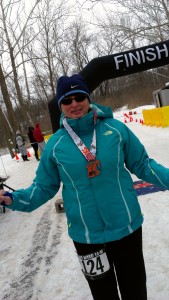Four lessons learned while running in one foot of snow
By Nancy B. Loughlin
Published in News Press on March 18, 2014. Posted with permission.
1. Anyone can freak out. Anyone.
When I’m in hot water, I understand getting mad. It’s my go-to emotion. I have tools for navigating rage: lion’s breath, counting to ten, a five-mile run, stepping back one foot both metaphorically and literally. But, when it comes to panic, the “Oh, My God. I’m Going to Die!” thing, I’m not so adept.
The start gun exploded at 9 a.m. I was set to run ten miles in majestic Wyandotte County Park in Kansas City. It was 15 degrees, no sun, wind, and one foot of snow snuggled the ground. I wasn’t even a quarter of a mile in when I couldn’t lift my feet. The snow was glue. My legs were iron, and I was reduced to slow motion. I started to shake, and my scattered thoughts clawed to find my yoga.
The seasons correspond to Ayurvedic doshas, and this Floridian’s heat can handle angry pitta fire. But snowy winter invites vata’s flighty panic. I curled my hands into fists, and stomping my feet seemed reasonable. I wailed under the canopy of snow-covered pines.
2. Be like water.
Trail runs are treacherous enough. A technical run like Wyandotte demands that your eyes never leave the ground lest you become airborne. Shifting rocks and exposed, lifted roots are dangerous enough, but when they are covered with snow, the run becomes a deathtrap. It’s a sea of surprises under a blanket of white.
Contrary to mass opinion, the runners that trample the trail before you do not flatten the snow and clear the path. It is a road most traveled, and no one is making any difference.
This February snow in Kansas had the consistency of mashed potatoes. As I approached the half-mile marker, I began to lose hope. Running was impossible for me, and I was puffing out my mouth. Some unknown part of me began to wish for skis. Skis!
Instead of lifting my feet and kicking back my heels only to drop onto the rocky terrain, I slid my feet parallel to the earth, staying grounded, staying connected. I dropped my runner’s 90-degree arms and extended my limbs to wings, pumping my body along.
I respected my landscape and finally moved forward.
3. The terrain may be the same, but the experience is individual.
Okay, so it ceased being a run. It wasn’t really a hike; perhaps it was a dance. But it was mine. And I was going to define it and label it.
I reached the top of one of many Kansas City hills. I teetered on the edge of a 100-foot drop, and paused to take a picture of the expanse of white below, a dam and an ancient train track. I breathed in the icy air, coughed an exhalation. My entire respiratory system was raw. A speedier runner on his second lap moved passed me and said, “Enjoy your run, your hike, whatever…” I silently watched him head downhill to promptly toe a root, fly into the air, spiral, and land unceremoniously in a snow drift.
There is karma.
4. Some endeavors are supposed to be hard.
I did everything I could to insulate myself from the severity of the experience. I wore two pairs of socks, but my feet were still cold. Some runners packed their shoes with foot warmers only to yank them out later because their feet were mashed inside their shoes. Another runner posted Facebook pictures of two frostbitten toes.
My new North Face coat kept me warm, too warm, but I wasn’t about to strip and leave $300 in the woods. When the wind kicked up and slithered beneath my waistband, my sweat-soaked torso shivered. The facemask was terrific until every exhalation fogged up my glasses.
This was hard. It was the hardest ten miles I’ve ever done. It was the hardest ten I’ve ever crawled. The word of the day, even from the elites, was “brutal.
It’s okay to be hurt and pissed and flipped and continue to try and try. It was the brutality that made it beautiful.

